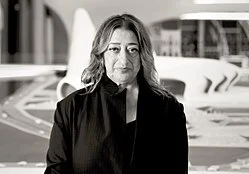Zaha Hadid architecture design
Zaha Hadid: Shattering Architecture’s Glass Ceiling

Introduction
Zaha Hadid was a force of nature in the field of architecture, a woman whose visionary sensibility and formidable personality have reshaped skylines and redrawn the boundaries of buildings. Born in Baghdad in 1950, she rose to prominence in a profession long men dominated and was for award- the Pritzker Architecture Prize in 2004, the first woman to receive it. This blog explores her extraordinary life, her pioneering contributions, and the lasting impact she made.
Early Life and Education
The Formative Years
Zaha Hadid came from an illustrious family in Iraq. Her father, Mohammed Hadid, was a powerful politician and industrialist, and her mother, an artist. With her liberal, intellectual upbringing, Hadid got expose to multiple fields and thoughts. She spent much of her childhood traveling and attending Catholic schools in Iraq and Switzerland, forging a global perspective early in life.
Architect with the interest in :Architecture Studies in London
Zaha Hadid arrived in London in the 1970s to study at the Architectural Association School of Architecture. It was a transformative time at the AA. Under the influence of avant-garde architects Rem Koolhaas and Elia Zenghelis, Hadid developed an audacious, experimental style. Her thesis project, “Malevich’s Tektonik”, was an homage to the Russian Constructivists and a hint of her work to come — straying into radical geometry and abstraction while incorporating movement.
An Early And Difficult Career
Establishing Her Own Firm
In 1980, Hadid established her own London based architecture office, Zaha Hadid Architects (ZHA). The firm confronted various obstacles, not the least of which was the reluctance of the architectural world to accept a female-led practice whose designs were highly conceptual. Many of her early commissions went unbuilt, leading to her being known as a “paper architect.”
The Turning Point
Architectural breakthrough For Hadid, that building got completion in 1993, the Vitra Fire Station in Weil am Rhein, Germany. It was small in scope, but was a step toward converting her abstract images into reality. A sculptural composition of sharp angles and dynamic planes, it heralded Hadid’s move from idea to building.
Breaking Through: Major Works
MAXXI Museum, Rome
Hadid’s fluid architectural vocabulary made in projects like the MAXXI – Museum of 21st Century Arts in Rome, which was completed in 2009. The building blurs the distinctions between inside and outside, a meandering concrete shape with intersecting pathways that invites exploration and interaction. It won the Stirling Prize in 2010.
Guangzhou Opera House
Twin pebbles on the riverbank is how the Chinese Guangzhou Opera House, which opened in 2010 and described. Its form and geometry serves to improve acoustics and enable an engaging spectator experience, weaving within the urban framework of the city. It became a symbol for China’s cultural aspirations.
London Aquatics Centre
It is perhaps her best known public work in the UK and known to built for the 2012 Olympic Games, the London Aquatics Centre. The roof’s cascading curves are meant to create the sensation of the movement of water, a fitting metaphor for the mission of the building. The design was loud for its architectural and operational efficiency.
Other Notable Projects
Heydar Aliyev Center (Baku, Azerbaijan)
The building’s undulating, wave-like design has made it a tour de force of contemporary architecture.
Dongdaemun Design Plaza (Seoul, South Korea)
A futuristic urban development designed for public space, retail and exhibition.
Galaxy SOHO (Beijing)
A commercial structure of interlocking, fluid forms, and a clear demonstration of Hadid’s philosophy regarding fluidity of space.
Overcoming the Gender Barrier

A Male-Dominated Field
Architecture has always been a boys club. While women in architectural education were on the rise, the same could not be said for leadership and prestigious commissions. Hadid’s ascent was itself an affront to those norms.
Paving the Way for Others
In 2004, her being awarded the Pritzker Prize was a watershed not just for her career but for women in architecture in general. Hadid frequently described her hardships as a woman for being from the Middle East in a male and Western-dominated field. She is the one of the woman architects who encouraged a whole lot of other women to take-up architecture with their heads up high.
Philosophy and Design Ethos
Deconstructivism and Fluidity
Hadid’s work has been deemed deconstructivist, referring to a type of design that scorns traditional rectilinear forms. Her buildings are dynamic, fluid, and appear to be in motion. She spurned the orthodoxy of the grid and embraced a visual language that valued complexity.
The Role of Technology
In the vanguard in its use of digital technology, Hadid’s firm employed advanced computer modeling to achieve its sinuous forms. Her parametric designs gave rise to buildings with nature-inspired shapes and structural behaviors never seen before, revolutionizing the field of engineering and construction methods.
Art, Mathematics, and Nature
Her influences were many and varied: Russian Suprematism, Islamic calligraphy, natural topographies, mathematical patterns. Her work frequently has the look of formations in nature — rivers, dunes and coral reefs — but is determinedly future-forward.
Legacy and Influence
Awards and Accolades
Zaha Hadid’s honors include:
- Pritzker Architecture Prize (2004)
- Stirling Prize (2010, 2011)
- RIBA Gold Medal (2016) – the first woman to win it on her own.
- Dame Commander of the Order of the British Empire (DBE) Honour given for services to international development, overseas exports, and charity causes.
Continued Impact Through ZHA
Zaha Hadid Architects has furthered her legacy since she died in 2016. Under the guidance of Patrik Schumacher the office continues to be a leading protagonist in designing and technology. Recent projects include the Beijing Daxing International Airport and the Al Wakrah Stadium in Qatar.
Impact on Modern Architecture
Her influence spreads beyond her constructed work. She was instrumental in redefining architectural education and theory, and in teaching architects to subvert constraints and upend orthodoxy. Xenophobia Her message is still relevant in advocating for diversity in architecture.
Criticism and Controversy
Design Practicality
Some critics said Hadid’s designs were more about visual excitement than utility. Complex shapes could also result in higher costs and construction difficulties sometimes prevailed. But a lot of her designs have been praised for how well they work after everything is finished.
Labor and Ethics
Hadid also came under scrutiny for accepting work in areas with controversial labor practices, particularly the Gulf. In her own defense, she traced the balance of power between developers and local government, underscoring how little control architects can have over labor conditions.
Personal Life
A Complex Persona
Zaha Hadid had a forceful personality; she was often described as uncompromising and assertive. With high standards and relentless drive, she was both admired and criticized. But closer acquaintances also describe her as warm, funny, loyal.
Artistic Pursuits
Alongside architecture, Hadid also worked on furniture, jewellery and fashion. Her partnership with Chanel, Louis Vuitton and Swarovski were some of her projects fine art collaborations. They were part of her conviction in art and design as fundamentally unified, irrespective of the scale of the work or the discipline.
Conclusion
A Lasting Legacy
Zaha Hadid’s life and output are a testament to the ambition that vision needs to be met with. She made architecture into an art that soars beyond the expected, cheered complexity, movement and, above all, inclusivity. Her legacy is still evident in the world in which we live.
Inspire Future Generations
Hadid’s influence extends well beyond her buildings. She encouraged a generation of architects, especially women and minorities, to take on the establishment. She is a shining light for creative spirit, daring and change.
References and Additional Reading
[1] S. Boztug, V. Reichenberger and J.C. Willems, A note on feedback stabilization for non-square systems Systems Control Lett.
Books
- ‘Zaha Hadid: Complete Works,’ by Aaron Betsky
- Zaha Hadid Architects: Redefining Architecture and Design, by Zaha Hadid Architects
Articles
- Architectural Digest: “Zaha Hadid’s Most Iconic Buildings”
- Dezeen: “The Riches of Zaha Hadid”
Documentaries
- “Zaha Hadid: Who Dares Wins” (BBC Documentary)
Leave a Reply
Want to join the discussion?Feel free to contribute!